The general kinds of Korean Food 
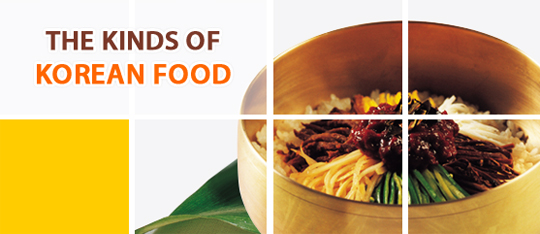
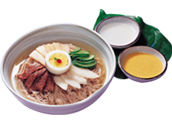
-
1) Bap (Rice)
Bap, a staple of Korean food, is steamed rice. It may also include other grains. There are many kinds of bap depending on the ingredients such as huinbap (white rice); japgokbap (rice with barley, millet, and beans); byeolmibap (rice with vegetables, seafood and meat); and bibimbap (rice mixed with namul and beef). -
2) Juk (Porridge)
Juk is one of the Korean dishes that was developed in early times. It consists of grains simmered for a long time with 5 to 7 times the volume of water. There are many varieties of juk depending on the ingredients. Juk is not only served as a main dish but it can also be part of a special meal. It is served to patients and eaten for health. -
3) Guksu (Noodles)
Korean noodles are made by kneading wheat flour or buckwheat flour and drawing the dough into long coils. Noodles helped develop the use of chopsticks in Korea. -
4) Mandu and Tteokguk (Dumpling soup and Sliced rice cake pasta soup)
Mandu is a dumpling made of thin wheat flour wrappers stuffed with fillings then steamed, or boiled in jangguk (soy sauce soup). It is a specialty of the northern area of Korea. Tteokguk consists of diagonally sliced white rice cakes that are simmered in jangguk. It is served on the first day of the year.

-
1) Guk (Soup)
Guk is a soup of vegetables, seafood and/or meats boiled in plenty of water. Some varieties are malgeun-jangguk (clear soy sauce soup), tojangguk (soybean paste soup), gomguk (rich beef soup) and naengguk (chilled soup). The standard Korean table setting always has bap and guk. Guk has helped develop the use of spoons in Korea. -
2) Jjigae (Stew)
Jjigae has less water and more solid ingredients than soup, and it is saltier. Varieties include malgeun-jjigae (clear jjigae) and tojang-jjigae (soybean paste jjigae). -
3) Jeongol (Hot pot)
Jeongol started as a royal court food. It consists of meat, seafood, mushrooms and vegetables simmered in broth at the table just before serving for dinner or as a dish to accompany liquor. 
-
4) Jjim (Steamed dish)
Jjim is a dish of main ingredients cooked with seasonings in deep water. It may be boiled with soup just above the solid ingredients, or steamed. -
5) Seon (Steamed or parboiled stuffed vegetables)
Seon means “good ingredients.” It is a dish of vegetables such as pumpkin, cucumber, eggplant and cabbage or tofu stuffed with beef and/or mushrooms that is steamed or parboiled in broth. -
6) Jorim (Braised dish)
Jorim is a cooking method to braise meat, seafood or vegetables with soy sauce or red pepper paste on low heat. The ingredients are cooked for a long time to allow the flavors to seep in. It may have strong seasonings and can last a long time. -
7) Cho (Janggwa) (Seasoned and braised seafood)
Cho (janggwa) is a dish of boiled sea slugs, abalone and mussels with seasoning on low heat. Then starch liquid is added and boiled. The resulting soup is quite thick and glossy. -
8) Bokkeum (Stir-fried dish)
Bokkeum is a stir-fry of meats, seafood or vegetables. There are two types of bokkeum dishes; one is just stir-fried in an oiled frying pan, the other one is stir-fried with soy sauce and sugar. -
9) Gui (Grilled dish)
Gui is a dish of grilled meats, seafood or vegetables as is, or grilled after seasoning. -
10) Jeon. Jeok (Pan-fried dish. Brochette)
Jeon is a dish of pan-fried meats, seafood or vegetables after they have been minced or sliced and coated with wheat flour and beaten egg. Jeok is a dish of pan-fried ingredients after they have been seasoned and skewered. -
11) Hoe. Pyeonyuk. Jokpyeon (Raw fish/Raw meat. Pressed meat. Pressed
trotters)
Hoe is a dish of raw meat, fish or vegetables seasoned with vinegar soy sauce, vinegar red pepper paste, or mustard. It can also be blanched in boiling water. Pyeonyuk is a dish of pressed and sliced beef or pork. Jokpyeon is a dish of long-simmered ox-head and ox-feet that is solidified and sliced. -
12) Mareun-chan (Dry side dish)
Mareun-chan is a dry side dish made of salted and seasoned meat, seafood and/or vegetables that can be stored for a long time. It is enjoyed dried or fried. -
13) Jangajji (Pickled vegetables)
Jangajji is a side dish of pickled vegetables that include Korean radish, cucumbers, bellflower roots and garlic in soy sauce, soybean paste or red pepper paste. It can be stored for a long time. -
14) Jeotggal (Salt-fermented seafood)
Jeotggal is a side dish of marinated shrimp, anchovies or clams with salt that is fermented. It is served as a side dish or used as a seasoning. -
15) Sukchae (Parboiled vegetables)
Sukchae is a dish of parboiled vegetables. It may be mixed or fried with seasonings. Sukchae is a popular basic side dish in Korea. -
16) Saengchae (Fresh salad)
Saengchae is a seasonal fresh salad dressed with vinegar soy sauce, red pepper paste or mustard. It is sweet and sour. This method of preparation is best for preserving the taste and most of the nutrition in the ingredients. -
17) Kimchi (Seasoned and fermented vegetables)
Kimchi is a dish made by marinating Korean cabbage and Korean radish with salt, seasoning it with red pepper, garlic, green onion, ginger and salt-fermented seafood, mixing it thoroughly and letting it ferment. Kimchi is the quintessential side dish in Korea. It is a typical fermented and storable food.

-
1) Tteok (Rice cake)
Tteok is a dish made by steaming, frying, or boiling rice powder or other grain powder after it has been sprinkled with water. It is served at ceremonies and holidays without fail. 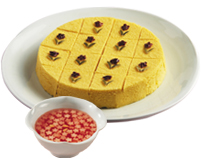
-
2) Hangwa (Korean cookies)
Hangwa are traditional Korean cookies. There are many varieties depending on the ingredients or recipes such as yumilgwa, gangjeong, sanja, dasik, jeonggwa, suksilgwa , gwapyeon, yeotgangjeong and yeot. -
3) Eumcheong (Beverages)
Eumcheong are non-alcoholic beverages.
* Source: The beauty of Korean Food: With 100 Best-loved recipes by Institute of Traditional Korean Food
History of Kimchi

•
Origin of Kimchi
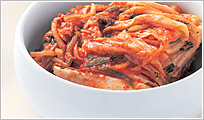

For as long as humans have been cultivating they have enjoyed the nutritional elements of vegetables. However, the cold winter months, when cultivation was practically impossible, soon led to the development of a storage method knowns as 'pickling'. Rich in vitamins and minerals, kimchi was conceived in Korea around the 7th century.
• Use of Hot Red Pepper Powder
Many years ago, kimchi was merely regarded as a salted vegetable. Yet, throughout the 12th century, with the addition of several spices and seasonings, it grew steadily in popularity. It wasn't until the 18th century that hot red pepper was finally used as one of the major ingredients for making kimchi. In fact, the very same kimchi as we know it today has retained the same qualities and cooking preparations that prevailed ever since it was first introduced.
• The Origin of the Name, Kimchi
It is suspected that the name kimchi originated from shimchae (salting of vegetable) which went through some phonetic changes: shimchae - dimchae - kimchae - kimchi.
• Reasons Why Kimchi Was Developed in Korea
Few fermented vegetable foods are found worldwide. Some possible reasons why kimchi was developed as a fermented food especially in Korea are as follows: (1) vegetables were popular to the ancient people in Korea whose main industry was agriculture; (2) Koreans had a remarkable technology for salting fish which was frequently used as a seasoning; (3) cabbages (brassica) appropriate for making kimchi were widely grown.
• Major Historical Periods of Korea
The development of kimchi is reportedly rooted in the agrarian culture that began before the era of the Three Kingdoms on the Korean Peninsula. Due to the cold Korean winter, they had to come up with the storage technology for vegetables as a means of securing food.
- Kimchi in Ancient Times
It is difficult to identify the development of kimchi throughout ancient times, as historical records remain scarcely available. We can only assume that they simply salted vegetables in order to preserve them as long as possible.
- Kimchi during the Goryeo DynastyAlthough there are records that clearly indicate the root of kimchi's discovery, cabbage was first mentioned in an oriental medicine book titled 'Hanyakgugeupbang'. There were two types of kimchi - jangajji (pickled vegetables) and sunmu sogeumjeori (salted radish). In this period, kimchi began to receive new attention as a processed food enjoyable regardless of season as well as storage food for winter. It is suspected that the development of seasonings at that time enabled spicy kimchi to appear. 
- Kimchi in the Joseon Period
It was after foreign vegetables, in particular, cabbages (brassica) were introduced and used as the main ingredient that the current form of kimchi was conceived. Hot red pepper was imported to Korea from Japan in the early 17th century (after the Japanese invasion of Korea in 1592), but it took roughly 200 years until it was actively used as an ingredient in kimchi. Therefore, it was only during the late Joseon period that kimchi became associated with its red color.
• Royal Court of Joseon 
-
Kimchi in the Royal Court of Joseon
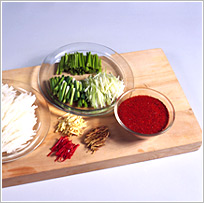

Normally three types of kimchi- whole-cabbage kimchi (jeotgukji), diced-radish kimchi (kkakdugi) and water kimchi, were served to the kings of Joseon. Jeotgukji for a good deal of pickled fish was added to the kimchi. A cooking book of Joseon, Joseon massangsansik yorijebeop, explains how to make jeotgukji as follows:
First, cut well-washed cabbages and radishes into small chunks and salt them. Second, mix them with chopped hot red pepper, garlic, dropwort (minari), leaf mustards (gat) and some seaweed. Third, boil fermented fish in some water and cool it. Fourth, add the fish to the above mixture. Fifth, store it in a pot and wait till it is fermented.
Even though the main ingredients of water kimchi (dongchimi) are radish and water, more garnishes were used to enhance the taste in the royal court of Joseon. The radishes used for water kimchi should be of a wholesome shape. In addition, they should be washed and salted for a day before being stored in a jar buried under ground. There is an anecdote that King Gojong, the second last king of the Joseon Dynasty, liked cold noodles in dongchimi juice mixed with some beef juice as a winter-night-meal. Hence, special water kimchi was prepared with pears, which were exclusively used for the cold noodles.
- Modern Kimchi
Kimchi has been scientifically proven to be high in nutrition and is often recommended as a valuable food source both at home and abroad. In fact, there has been a significant increase in kimchi exports in recent years. Korean immigrants to China, Russia, Hawaii and Japan first introduced kimchi abroad, and have continued to eat kimchi as a side dish. It gradually gained popularity even among foreigners. Accordingly, kimchi may be found wherever Koreans live. In America and Japan especially, where relatively many Koreans live, packaged kimchi is easily available. In the past, the production and consumption of kimchi was confined to Korean societies, however, in recent years it has become a globally recognized food.
Source : http://english.visitkorea.or.kr/enu/FO/FO_EN_6_5_1.jsp
댓글 없음:
댓글 쓰기